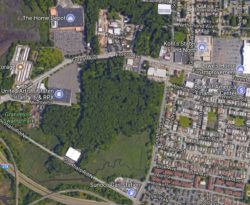
Satellite View of Project Area. Image Credit: Google Maps.
A wholesale club and retail center will be developed on Staten Island Wetlands in Mariners Harbor. On October 31, 2017, City Council passed the South Avenue Retail Development land use actions by a vote of 45-1. The special permit and City map amendment will facilitate the development of five new retail buildings in Mariners Harbor, Staten Island. The special permit allows the retail buildings to be developed in excess of 10,000 square feet to accommodate use for a supermarket. The City map amendment will removed mapped but unbuilt streets from the project area’s wetlands to prevent future development. For CityLand’s prior coverage on the matter, click here.
Mariners Harbor, Staten Island is an environmental justice community. Council Member Debi Rose of District 49, where the development will occur, has facilitated many conversations between the community and project developers to ensure smart planning. While explaining her vote at the October 31st Council meetings, Council Member Rose noted that a “no” vote from the Council on this project will not prevent development on the site, because the current zoning does allow commercial use. The developer asking for a special permit and City map amendments allowed the Council to review the development and attach commitments such as local hiring and increased environmental protection.
I. Local Hiring
The M1 zoning district allows for limited commercial development, but not in excess of 10,000 square feet. The special permit, which allows development over 10,000 square feet, will grant the applicant flexibility in selecting commercial tenants. The applicant has entered into a lease with BJ’s Wholesale Club pending this special permit approval.
The Vice President of Real Estate for BJ’s Wholesale Club, Pat Smith, testified in support of the project at the October 10th Subcommittee on Zoning and Franchises meeting. BJ’s pledged to create 200 permanent jobs. They will host job fairs so that 100% of the jobs will go to community residents. The progress of this goal will be reported to Council Member Rose. When concerns were raised about competition with the nearby Sunoco gas station, BJ’s noted that they met with Sunoco’s owner and stressed that BJ’s gas station is only accessible to club members. Also, every BJ’s club has a community captain to ensure they are being a good corporate neighbor.
The site manager testified that they want to use Staten Island developers and will take local input on the remaining commercial tenants.
II. Environmental Impact
Of great concern to the environmental justice community is the project’s environmental impact. The applicant’s representative described decades of work with the New York State Department of Environmental Conservation (“NYSDEC”) to find the balance of conservation and development of the project. The applicant purchased the property in 1977, before the wetlands were mapped. When the wetlands were mapped in 1987, the applicant appealed to the NYSDEC and has been working on a development proposal ever since. While the development is occurring on the northern portion of the 28.3 acre project area, 10.77 acres on the southern NYSDEC-regulated portion will be preserved and enhanced. 6.94 acres will be preserved. 3.83 acres will be enhanced with buffers and plantings, including 2,200 new trees and 9,000 new shrubs. Within the special permit, mandatory stormwater maintenance is deed-restricted in perpetuity, meaning the developer must adjust stormwater maintenance if it fails. The proposed project can maintain 9.2 inches of flooding with a 15% emergency service capacity. The developer also doubled the required size of bioswales from 8 feet to 16 feet wide.
However, 1,800 mature trees will be removed to facilitate the development, and it will take decades for the 2,200 new trees to fully mature. Many environmental activists from the community testified in opposition to the project at the October 10th Subcommittee meeting. After Hurricane Sandy devastated coastal neighborhoods, the preservation of this neighborhood was attributed to the wetlands and woodlands. Many homes on the south of Staten Island were destroyed, and residents blamed excess development. Speakers testified that these wetlands saved their community from Hurricane Sandy, and sea levels have only risen since then. While the developer’s proposed mitigation of the environmental impact was recognized, those opposed believe that any mitigation will not cure the effect of destroying the wetlands and mature trees.
Council Member Inez Barron, the sole “no” vote at the October 31st Council Meeting, stated that bioswales and other mitigation tactics are not a replacement for the buffer nature provides with the wetlands, which protected this community during Hurricane Sandy.
CC: South Avenue Retail Development (LU 0759-2017; LU 0760-2017) (Oct. 31, 2017).
By: Shelby Hoffman (Shelby is the CityLaw Fellow and a New York Law School Graduate, Class of 2017.)


The Coalition for Wetlands and Forests remains opposed to this project.